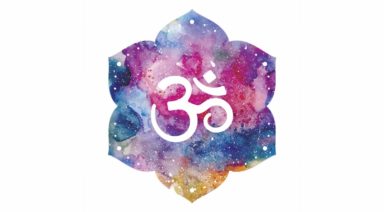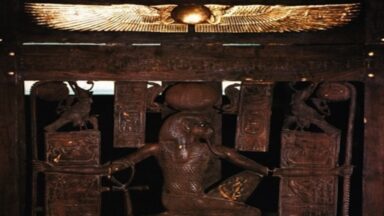What is the Meaning of Om?

“In the beginning was the Word, and the Word was with God, and the Word was God.” It is a particularly human trait to be curious about our origins, and the origins of our universe. How could so much – the diversity of our planet, the vastness of our solar system, the unknown reaches of space – come from nothing? Spiritual traditions from all over the world have grappled with this question, and have recognized the profound role of the Divine Word as the origins, the beginning, of the universe. If at first there was nothing, the very first thing was a sound vibration, and from there, everything sprang into existence, and the material world was born. And Western science is now coming on board as well: quantum physicists have been studying the role of vibration at the root of matter itself.
Nikola Tesla said, “If you want to find the secrets of the universe, think in terms of energy, frequency and vibration.” The very foundations of our Universe, of matter and thought, appear to lie in sound vibration.
And from a yogic perspective, there is a profound connection between speech (the expression of our thoughts) and prana (the life energy carried on the breath). When we speak, we are naming our reality while using the power of the breath to form and express our words. Speech is prana in action. Prana naturally creates sound.
Masaru Emoto, the Japanese researcher who explored the effects of the sound of different words on water, demonstrated the power of our speech and our intention on the matter around us and within us. The potential of sound vibration and intention in creating our reality has been explored in great depth by the ancient yogis, as well as in modern authors like Esther Hicks. Sound healers use chanting and toning to create profound transformation in the body and mind. How to make sense of it all? Perhaps the best place to start is at the beginning.
Perhaps you’ve heard people chanting the sound OM in a yoga class, or listened to a devotional music CD. Or you’ve seen the strange but beautiful symbol on a poster or on someone’s T-shirt. This Sanskrit syllable has become commonplace among yogis and people interested in eastern spirituality, but how many of us really understand its significance, or know how it can support our spiritual practice and growth? This article will explore the meaning, origins, and use of this powerful symbol.
The Cultural and Historical Roots of OM
The syllable OM is an ancient Sanskrit letter first found in the Vedas, originating between 1500 – 1200 BC. A collection of Vedic Sanskrit hymns, they were sung in praise of the Divine. They were not written out at first but were vibrated into existence using human speech. Teachings on the metaphysics of OM were later elaborated on in the Upanishads, ancient Indian mystical texts. Later, the Yoga Sutras of Patanjali categorized the ‘eight limbs of yoga.’ The sixth of these, Dharana, meaning concentration, described various methods of supporting the mind to achieve single-focused attention. Repeating a mantra, and especially this syllable OM, was an important aspect of accomplishing this sixth stage of yoga, or union with the Divine origins. Anne Dyer, sound yoga expert, in an interview with Rodney Yee, explains that Patanjali taught: “Chant Om and you will attain your goal. If nothing else works, just chant Om.”
SreeDevi Bringi, a scholar in eastern religions and yogic studies from Naropa University, states that the main teaching of OM in these ancient texts was to experience non-dual awareness, which is also the goal of all yogic practice.
What is OM? The Primordial Seed Syllable Mantra
Seed, or bija, mantras are single syllable mantras from the Sanskrit language. There are eight primordial shakti seed syllables, including OM. David Frawley, in his book Mantra Yoga and Primal Sound, wrote: “Shakti bija mantras are probably the most important of all mantras, whether for meditation, worship of deities, energizing prana or for healing purposes. They carry the great forces of nature such as the energies of the sun and moon, fire and water, electricity and magnetism, not simply as outer factors but as inner potentials of divine light. They project various aspects of force and radiance for body, mind and consciousness. They hold, resonate, and propel the Kundalini force in specific and transformative ways. Below is a simple table of the main energies (Shaktis) of the Shakti mantras.”
Pranic energy:
- Om pranic energy
- Aim energy of sound
- Hrim solar energy
- Shrim lunar energy
- Krim electric energy
- Klim magnetic energy
- Hum power of fire
- Hlim power to stop
- Strim power to stabilize
- Trim power to transcend
OM, the first of these syllables and carrying immense pranic life force energy, is a mystic syllable, considered the most sacred mantra in Hinduism and Tibetan Buddhism. It appears at the beginning and end of most Sanskrit recitations, prayers, and texts. Om Namah Sivaya is just one of many examples where OM is included within a larger mantra, at the beginning. Considered to represent the primal or primordial sound of the Universe, OM connects us to and carries the Divine in vibrational form, making our prayers and mantras more effective with its increased pranic energy.
What is the Meaning of OM?
Seed mantras like OM are no ordinary words with dictionary definitions. These mantras are more about the vibrational content than the meaning. Frawley again: “Om is the Word of God.” The sound OM is a vibration from which all the manifest universe emanates. Form and creation come from vibration. OM is the most elemental of vibrations. It is the sound of the void. Frawley says: “Om is the prime mantra of the Higher Self or Atman. It attunes us with our true nature. It is the sound of the creator, preserver, and destroyer of the universe, who is also the inner guru and prime teacher. It reflects both the manifest and un-manifest Brahman, sustaining the vibration of being, life, and consciousness in all worlds and all creatures.”
AUM – Creator, Preserver, Destroyer
OM is also sometimes written and pronounced AUM, a prolonging of the individual sounds contained in OM. Each of the three letters, and sounds, corresponds to a different aspect of the divine. The first sound, A, invokes Brahma, the creative aspect. The U sound invokes Vishnu, the preserver. And the M sound, Shiva, represents the destructive aspect of God. So the three sounds in this one syllable remind us of these three aspects of the Divine, without which nothing exists, everything is sustained, and all things dissolve back into the void. After one chants AUM and has taken this journey through the transformation of the cosmos, it is traditional to pause and sit in silence, and experience that creative void, vibrating with that primordial vibration.
OM and Amen
According to Paramahansa Yogananda, author of the classic text Autobiography of a Yogi: “Om or Aum of the Vedas became the sacred word Hum of the Tibetans, Amin of the Moslems, and Amen of the Egyptians, Greeks, Romans, Jews, and Christians.” The syllable has been translated into many different languages, cultures, and religious traditions, but the creative and transformative power of the sound remains the same. In the Bible, the word Amen is connected to the beginning of the creation of the Universe: “These things saith the Amen, the faithful and true witness, the beginning of the creation of God.”
How to Harness the Power of OM
In the yogic tradition, a mantra is a powerful tool to focus and quiet the mind. Try breathing deeply and repeating the sound OM while holding your awareness at the crown of your head, or the third eye point at the brow. Or repeat OM or a mantra that incorporates OM, 108 times with the help of a mala. Called Japa Yoga, this keeps the mind focused and infuses the body, mind, and heart with the qualities of the mantra.
In the Bhakti (devotion) yoga tradition, singing or chanting the names of God opens the heart and brings one to a state of bliss. Om Gam Ganapataye Namah invokes and praises Ganesha, the God of abundance and destroyer of obstacles. By chanting OM before the rest of the mantra, one calls on the power of the word and the primordial origins of sound.
OM is most associated with the 6th (brow point) and 7th (top of the head) chakras. Other syllables are connected to each of the other chakras. Try chanting these as you focus on each chakra or area of the body:
- “LAM”- chakra 1 (root)
- “VAM”- chakra 2 (sacral/navel)
- “RAM”- chakra 3 (solar plexus)
- “YAM”- chakra 4 (heart)
- “HAM”- chakra 5 (throat)
- “OM”- chakra 6 (third eye/brow)
- “OM”- chakra 7 (crown)
Finally, Anne Dyer suggests that in our chanting practice, we progress from chanting OM out loud to whispering the syllable. This is training the mind to focus on the subtle. When we turn down the volume, we have to turn up our attention. When the mind is listening carefully, the mind isn’t busy thinking. In the silence, we might begin to hear the stillness, the sound of the void. Listening deeply to stillness is a profound meditative practice that connects us to the power of creation and the Divine.
In the end, exploring the syllable OM, and the power of sound can remind us to treat our words as sacred, creative, and Divine. What we think and say, we create. We are powerful creators! May our words, through our conscious use of them, regain their transformative power, and may the Divine speak through us as we bring more and more awareness to the vibrations that we create with our thoughts and words. Om Shanti.
The Meaning of Namaste

About 12 years ago, I double-parked and ran into an Indian food restaurant located in a strip mall in my hometown. I’d had an incredibly long day at work and was craving comfort food and my sofa. When I blazed through the door, I was greeted by a man who stood about the height of my chin. He was the host, the cook, the waiter, and, as I quickly learned, he was also the owner.
He met my cyclone of an entry with a steady kind gaze, and then simply pressed his palms together at his heart, and with a slight reverent bow, said “Namaste.” I had heard the word before, of course, but that moment was different. In that second I felt as though I had just been handed the Nobel Peace Prize. Simply for being me.
I felt seen in a way I never had. Not even by my family or friends or anyone I’d ever dated.
That feeling was created by that single word and his authentic gesture. It transformed not only my day, but also my belief in the power we all have to influence one another with our words, actions and presence. My craving for chutney had somehow ignited my investigation into the history of Namaste.
The Meaning of Namaste
Namaste is a Sanskrit word comprised of the root words “namah” and “te”. The meaning of namah, as described by Wikipedia, means “bow” and “reverential salutation or adoration”. It also means “obeisance” – not a word you may be tossing around with your homies, which means “a movement of the body expressing deep respect or deferential courtesy; a bow, curtsy, or other similar gesture”. The word “te” means “to you”. The “s” links the two words according to the grammatical rules in the language of Sanskrit, so that the sounds of the letters flow with one another. Hearing the resonance of these cohesive sounds shows how and why the language of Sanskrit is precisely aligned with the practice of yoga.
Do I Have to Bow When I Say Namaste?
Like a stiff new pair of jeans, beginning the practice of saying the word Namaste and/or holding your hands at prayer and bowing can feel really uncomfortable. For many born and raised in the western world, there is no cultural equivalent to the practice of bowing. This practice, “pranama” in Sanskrit, means “to bow” or according to Paramahansa Yogananda, “this salutation, with the hands in position of prayer, is expression of reverence to God or to one in whom the Divine is manifested. You may say Pranam or Namaste. This joining of hands symbolizes the meeting of two souls. Bowing down and joining hands symbolizes humility.”
Since Namaste literally means “bowing to you”, it’s a good idea to do just that. Otherwise, it’s as if you proclaim to really like someone while maintaining a poker face. Incorporating the action of bringing your hands to your heart, followed by a slight bow, authenticates the meaning of Namaste.
To Namaste or Not to Namaste
Beyond cultural bounds exists the universality of people greeting one another. Of course you can shake hands, hug, bow or extend a salutation in other ways. But a good Namaste goes a long way.
One of the things I’ve learned as a professional writer is: it’s not just the words we choose that matter, it’s how we use them and if we know what they mean that matters. Words have history, and every word we use carries it’s history with it. Namaste is often interchanged with Namaskar in parts of India and beyond. In ancient scriptures, such as the Taittiriya Upanishad, the practice of extending courtesy, honor and hospitality is expressed equally to guests and deities. It’s referred to as “Atithi Devo Bhav”, which translates to mean ‘the guest is god’. There are 16 forms of reverence used in “Pujas”, or ceremonies, in any place in which formal worship occurs. Namaste is one oform.
As a word and gesture, Namaste has a wide range of uses that can extend along the spectrum of meaning: Namaste or namaskar is used as a respectful form of greeting, acknowledging and welcoming a relative, guest or stranger. It is used with goodbyes as well. Namaste can be used to for both the recipient of a kind deed or favor, as well as by the one extending the giving. The use of Namaste is growing: it is widely used throughout India, Nepal, parts of Asia and beyond. It is often used in yoga studios and spiritual communities throughout the western world.
However, the word itself is incomplete without a connection to the person you are saluting. Eye contact and stopping to acknowledge and bow are equally important.
Namaste is about creating and honoring connection and exuding respect.
As Rodney Yee and Colleen Saidman Yee reflect in Yoga Talks: Why do we say Namaste, “Namaste is used as an expression of respect. The deepest part of me sees and honors the deepest part of you.” They go on to explain that it is a powerful word yet is also familial.
As the word Namaste travels West, it continues to morph into meaning many things to many people. Technically, can I say it to the guy who rotates my tires? The sweet lady who lets me go ahead of her to pay for my groceries? Of course. But it’s more commonly used in situations in which people share a similar view of spiritually or, as in the case with my quest for Chutney years ago, used by people steeped in traditions that teach seeing beyond the exterior to a person’s essence.
That said, I begin each and every yoga and Sanskrit class that I teach with Namaste.
Even when I’m teaching yoga on stand-up paddleboards in lakes, oceans and reservoirs. Regardless of the form of practice, I honor my teachers, and lineages of teaching by using the expression and bow of Namaste. But first I always take a breath. I’ve found for myself that a full conscious inhale and an equally conscious exhale helps to clear away any possible block to connect authentically with both the students present and what I’m about to teach.
How to Say Namaste
As both a teacher and student of Sanskrit for more than ten years, it’s my experience that, here in the U.S., Namaste makes the top ten list for Most Commonly Mispronounced Sanskrit Words.
It does not rhyme with Nescafe; Namaste is a three-syllable word. The emphasis is often incorrectly placed on the first syllable, and erroneously pronounced like ‘nom’. The correct pronunciation phonetically is nuh-mUH-st-hey with the emphasis on the second syllable. In Sanskrit, the ‘a’ sound is pronounced like the English ‘u’ or ‘uh’as in Muenster cheese. There’s a tiny pause, I call it a ‘prana pocket’ that exists just after the second “a” in Namaste, followed by “stay” which, in Sanskrit, sounds like you’re directing your dog to sit. The “t” in Sanskrit is created by placing your tongue in between your upper and lower front teeth, biting down slightly, then pulling your tongue straight towards the back of your throat.
It can feel strange, I know. Practicing that over and over, much like making the shape of Warrior 2 with our bodies, is like washing that new pair of jeans until they fit like you’ve worn them for a decade.
Your Own Private Namaste
One of my Sanskrit teachers gave me some of the best advice for getting comfortable with pronouncing and relating to the names of the postures (asanas) in Sanskrit: “you’ve got to date your asanas… in order to build familiarity, we need to spend time together. It’s no different with relating to the practice of yoga.” There’s no need to light candles and spread rose petals, although if that’s your jam, please go ahead. I’m simply suggesting that, rather than a drive through kind of connection; we spend some quality time with Namaste.
Five Ways to Embody Namaste
Choose Your Context
Try saying Namaste to people practicing next to you in a yoga class or to the cashier at the grocery store.
Look the Other Person in the Eye
In order to recognize the spark of divinity in someone, you must look.
Reverent Gesture
Bring palms to touch at your heart.
Correct pronunciation
Pronunciation phonetically is nuh-mUH-st-hey, with the emphasis on the second syllable.
Bow
It’s not bobbing your head and it’s not full prostration; keep your eyes up and see your gesture all the way through.
We participate in this ancient practice steeped in cultural history because it shows that we value each other, that you could literally turn someone’s day, week or life around in an instant. Exactly like that kind man in the Taste of India restaurant did so many years ago. He bowed to a part of me that I hadn’t yet recognized within my self. In order to see it in myself, I had to forge a relationship with Namaste. If you are going to use this powerful word, explore its meaning.





































